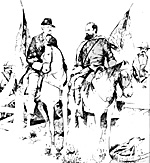The description of Petersburg could easily pass for a view of a World War
I battlefield. The similarity between the two is hardly coincidental. Indeed,
the two were both under the influence of a sudden increase in firepower
which began in the U. S. Civil War of 1861-1865.
The problem of the late nineteenth century armies was that the range, rates
of fire and accuracy of the new weapons were increasing at an astonishing
rate between 1860 and 1915. However, the mobility in battle was to remain
relatively unchanged. With such an increasing difference, fire, not
mobility, was beginning to dominate the battlefield. The armies were
becoming paralyzed by a firepower crisis that was to drive them below
ground at Petersburg and in France.
At the core of the emerging crisis in the 1860's was the muzzle-loading
percussion-lock rifle commonly known as the rifle-musket. The first
widespread use of the rifle-musket and other new rifled arms was to
profoundly influence the tactics of infantry, cavalry, artillery and the
combined arms in battle. The rifle-musket and the other weapons were to
strengthen the power of all arms while operating on defense. The massed
attacking columns of Napoleon's time were to give way under the
increasing defensive fire. A new kind of war fought more with the "spade"
and "bullet" was to emerge. The days of the bayonet were ending in the
Civil War and the day of the "bullet" was at hand.
More ACW Rifle-Musket
 Peering out from the bombproof bunkers one could see the opposing armies stretched out for miles along two zigzagging trench lines. Between
the two armies was a no man's land of wire, sharpened stakes and jagged,
deep ditches. Within the trenches soldiers of both armies crouched behind
the parapets in an effort to avoid the deafening screams of the incoming
shells. No one seemed able to leave the protective trenches. They knew
certain death awaited the next soldier bold enough to expose himself.
Under these conditions even the generals had to admit that an assault was
suicidal. Everyone seemed motionless except the steady stream of
wounded limping to the rear. This was not a war of military pagentry or
dramatic clashes of arms. It was a grinding war of survival.
Peering out from the bombproof bunkers one could see the opposing armies stretched out for miles along two zigzagging trench lines. Between
the two armies was a no man's land of wire, sharpened stakes and jagged,
deep ditches. Within the trenches soldiers of both armies crouched behind
the parapets in an effort to avoid the deafening screams of the incoming
shells. No one seemed able to leave the protective trenches. They knew
certain death awaited the next soldier bold enough to expose himself.
Under these conditions even the generals had to admit that an assault was
suicidal. Everyone seemed motionless except the steady stream of
wounded limping to the rear. This was not a war of military pagentry or
dramatic clashes of arms. It was a grinding war of survival.
ACW: Introduction
ACW: Infantry
ACW: Infantry Tactics (Examples)
ACW: Cavalry
ACW: Artillery
ACW: Engineers
ACW: Entrenchments
ACW: Grand Tactics
ACW: Tactics: Auerstadt 1806 vs. New Market 1864
ACW: Conclusion and Bibliography
Back to Conflict Number 7 Table of Contents
Back to Conflict List of Issues
Back to MagWeb Master Magazine List
© Copyright 1974 by Dana Lombardy
This article appears in MagWeb (Magazine Web) on the Internet World Wide Web.
Other military history articles and gaming articles are available at http://www.magweb.com